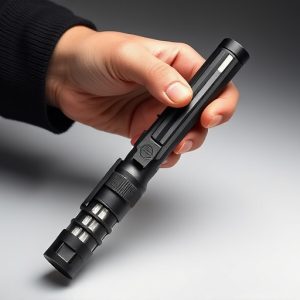Unlocking Defense: Baton Extension Mechanism Review
The self-defense expandable baton, a compact yet powerful tool, offers significant reach and versati…….
The self-defense expandable baton, a compact yet powerful tool, offers significant reach and versatility for personal safety and law enforcement. Its unique folding design and adjustable locking mechanism ensure stability and security during use, making it effective for crowd control, neutralizing attackers at a safe distance, and deterrence. With various length options, balanced construction, durable materials, and robust locking mechanisms, selecting the right baton involves considering comfort, effectiveness, and safety in potential threats.
“Discover the power of self-defense with a comprehensive review of the latest baton extension mechanisms. This article explores the revolutionary concept of the self-defense expandable baton, its unique unfolding design, and its multiple purposes. We dissect the intricate locking mechanism, revealing enhanced security features that ensure your safety.
From advantages to potential drawbacks, we evaluate performance and usability, guiding you in choosing the perfect baton for optimal self-defense.”
- Understanding the Self-Defense Expandable Baton: Unfolding Design and Purposes
- How Does the Locking Mechanism Work? A Deep Dive into Security Features
- Advantages and Potential Drawbacks: Evaluating Performance and Usability
- Choosing the Right Baton: Key Factors to Consider for Optimal Self-Defense
Understanding the Self-Defense Expandable Baton: Unfolding Design and Purposes
The self-defense expandable baton, also known as a tactical baton or extendable batons, is a versatile tool designed for personal safety and law enforcement applications. Its unique folding design allows it to be compact and easily carried, often fitting into a pocket or small bag. When deployed, this baton extends to a substantial length, providing a significant reach advantage for its user. This multi-purpose tool serves various purposes, from offering a deterrent against potential threats to being used as a striking weapon in self-defense scenarios.
The expandable design enables users to adjust the baton’s length based on their needs and the situation at hand. It typically features a simple locking mechanism that secures the baton in its extended state, ensuring stability during use. This feature is crucial for law enforcement officers who require a reliable tool for crowd control or in high-risk situations. Moreover, the self-defense baton’s versatility extends to its potential as an impact weapon, capable of neutralizing an attacker at a safe distance, making it an invaluable asset for individuals seeking effective personal protection.
How Does the Locking Mechanism Work? A Deep Dive into Security Features
The locking mechanism on a self-defense expandable baton is a critical component, ensuring the tool remains secure and ready for use when needed. This mechanism typically engages when the baton is fully extended, preventing it from retracting back into its handle. A simple twist or push of a button (or other activation method) locks the baton in place, making it readily available for self-defense scenarios.
Security features often include multiple locking points and durable construction to withstand strain. Some advanced models employ mechanisms that require a specific sequence or code to unlock, enhancing security further. These mechanisms are designed to be user-friendly, allowing for quick deployment during emergencies while ensuring the baton doesn’t accidentally retract when not in use. The robust design makes them ideal tools for personal safety and self-defense, catering to individuals seeking peace of mind in various environments.
Advantages and Potential Drawbacks: Evaluating Performance and Usability
The self-defense expandable baton, with its unique design and functionality, offers several advantages that make it a popular choice for personal safety enthusiasts. One of the key benefits is its versatility; the ability to extend and lock the baton provides users with additional reach and force when needed, allowing them to defend themselves effectively in various situations. This compact yet powerful tool can be easily carried, ensuring individuals feel more secure and empowered while going about their daily lives.
However, as with any self-defense weapon, there are potential drawbacks to consider. The locking mechanism, while crucial for performance, might add a slight delay during deployment, which could be critical in fast-paced, high-stress scenarios. Additionally, the learning curve associated with mastering the baton’s extension and locking techniques may deter users who prefer more instinctual self-defense tools. Despite these considerations, with proper training and practice, the benefits of this mechanism often outweigh the minor inconveniences.
Choosing the Right Baton: Key Factors to Consider for Optimal Self-Defense
When selecting a self-defense expandable baton, several crucial factors come into play to ensure optimal effectiveness and user safety. First and foremost, consider the overall length when extended. A longer baton offers greater reach, ideal for keeping attackers at bay, but it may also be less discreet in public places. Balance is key; you want a tool that feels comfortable in your hand, allowing for precise control during use.
Material quality is another essential aspect. Look for batons crafted from durable and high-strength alloys or steels to withstand impact without bending or breaking. A solid construction also guarantees the longevity of your self-defense tool. Additionally, pay attention to locking mechanisms; a reliable, secure lock ensures the baton extends and retracts smoothly and safely, providing peace of mind during potential confrontations.
The self-defense expandable baton, with its innovative locking mechanism, offers a powerful tool for personal safety. By understanding its unique design and security features, users can make informed decisions when choosing the right baton for their needs. While it provides significant advantages in terms of versatility and usability, it’s essential to consider potential drawbacks to ensure optimal self-defense. Navigating these factors empowers individuals to select a baton that best suits their situation, enhancing peace of mind in an unpredictable world.


